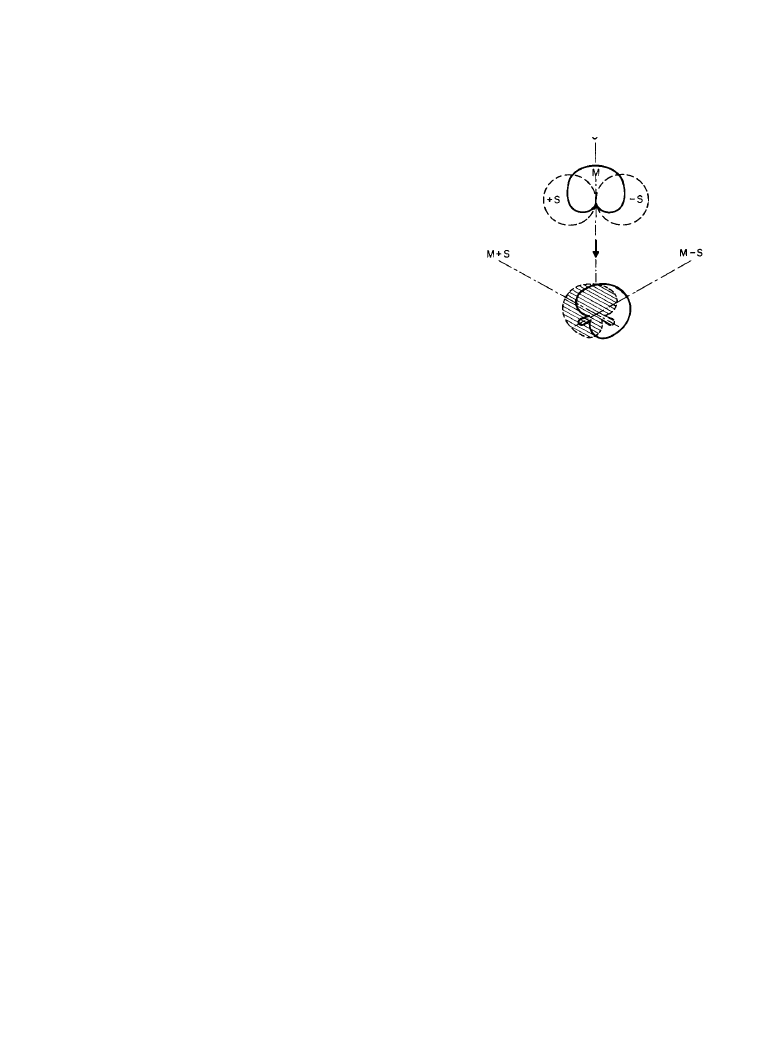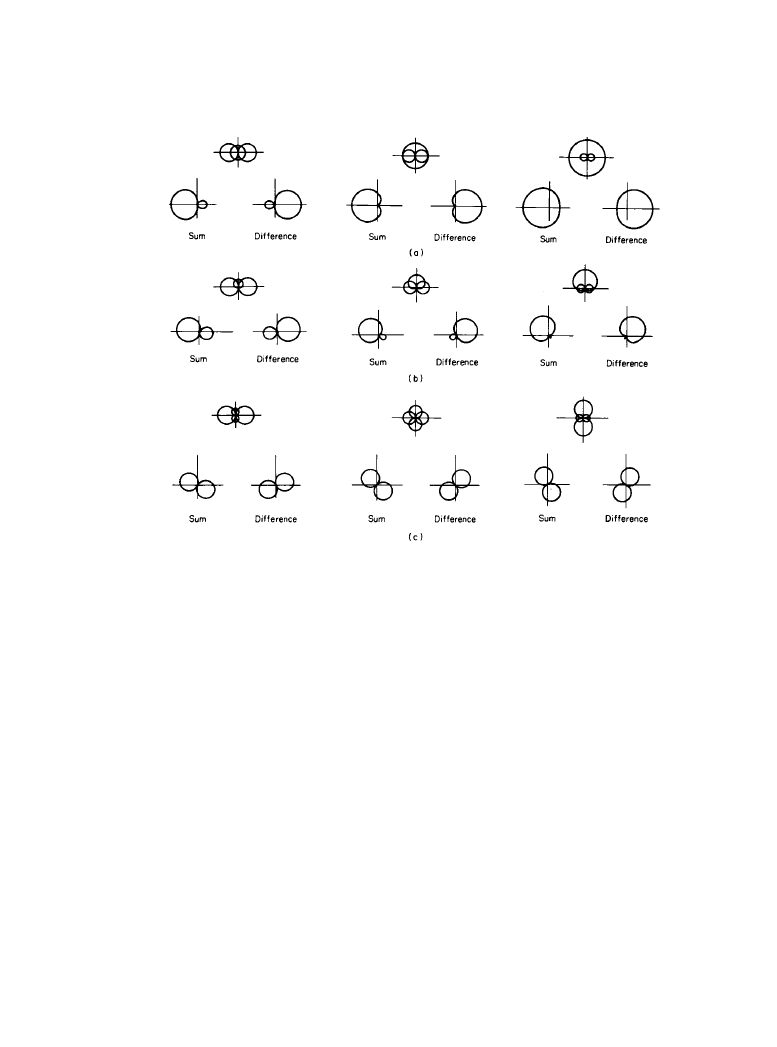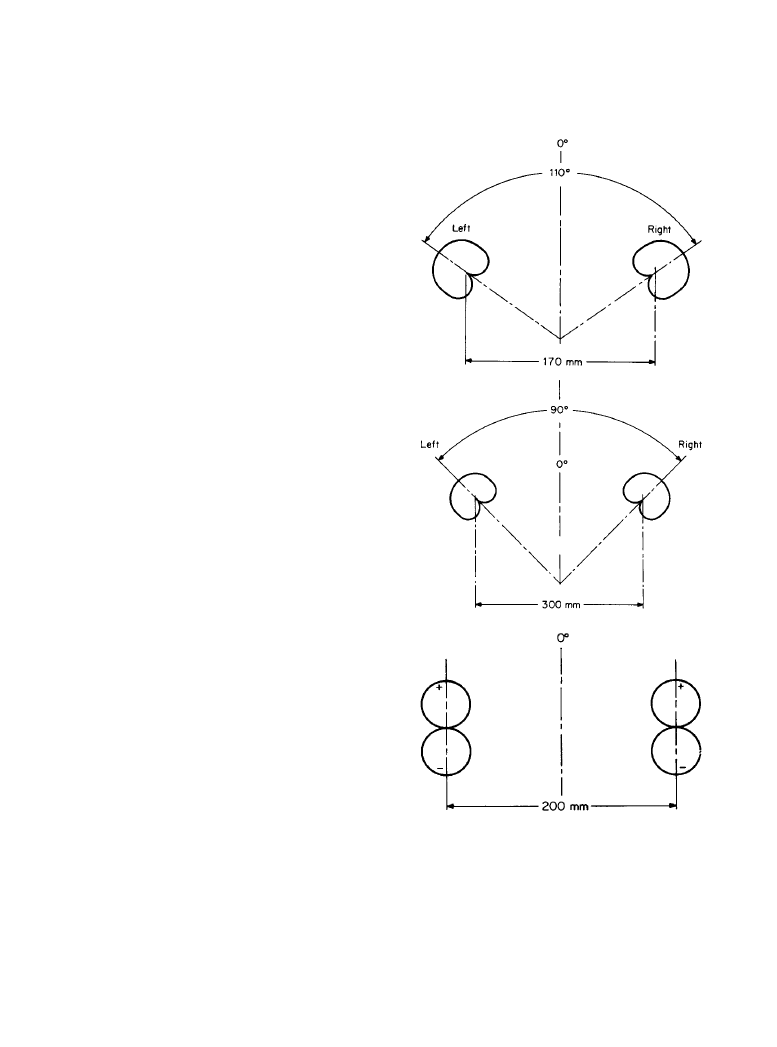ВУЗ: Казахская Национальная Академия Искусств им. Т. Жургенова
Категория: Книга
Дисциплина: Не указана
Добавлен: 03.02.2019
Просмотров: 21644
Скачиваний: 19

4-40 Microphone Devices and Systems
An advantage of this system is that it provides absolute monaural predictability: when the left
and right signals are combined, the sum is solely the output of the M component: (M + S) + (M –
S) = 2M. By judicious choice of polar pattern and placement of the M microphone, the monaural
signal can be optimized. Conveniently, this pickup is by definition on axis to the midline of the
sound source and suffers minimally from off-axis coloration. The S component (the bidirectional
microphone), with its null plane bisecting the sound source, provides more reverberant informa-
tion than the M component. As it is generally desirable that there be less reverberation in a mon-
aural signal than in stereo, there is a built-in advantage to MS in that it automatically has a less
reverberant character when summed to mono than in its stereo image.
Finally, the MS technique offers the mixing engineer greater control of the stereo image from
the mixing desk than available with any other technique. By changing the pattern of the M
pickup (using a remote-pattern microphone), the apparent distance from the sound source and
the amount of ambience inherent in the M signal can be adjusted. Furthermore, by varying the
M/S ratio in the sum-and-difference matrix, the apparent width of the stereo stage can also be
adjusted (Figure 4.2.6). This adjustment can be made either during the original recording session
or later, during a postproduction session [2].
4.2.2b
Two-Microphone Near-Coincident Techniques
This term is used to describe that class of techniques in which a microphone pair is placed close
enough together to be substantially coincident for low frequencies yet is far enough apart to have
an appreciable time delay between channels for sound sources located to the far right and left.
Such techniques otherwise differ little from coincident microphone configurations, except that
the stereo imaging results from differences in both intensity and time (phase).
The value of these techniques is that they exhibit good localization combined with a sense of
depth. Close miking is not recommended when using these techniques, since small movements
of the sound source can produce large image shifts. Sounds arriving from the far left or far right
can also create problems for disk cutting or monaural summation owing to interchannel time
delay.
The following examples illustrate some of the common configurations and techniques:
•
Figure 4.2.7 shows two cardioid microphones oriented outward from the centerline of the
sound source with an included angle of 110° and with a capsule spacing of 17 cm.
Figure 4.2.5
MS conversion to
XY.
Downloaded from Digital Engineering Library @ McGraw-Hill (www.digitalengineeringlibrary.com)
Copyright © 2004 The McGraw-Hill Companies. All rights reserved.
Any use is subject to the Terms of Use as given at the website.
Stereophonic Techniques

Stereophonic Techniques 4-41
•
Figure 4.2.8 shows two cardioid microphones oriented outward from the centerline with an
included angle of 90° and a capsule spacing of 30 cm.
•
Figure 4.2.9 shows two bidirectional microphones facing directly forward toward the sound
source, spaced 20 cm apart.
4.2.2c
Two-Microphone Spaced Techniques
Spaced microphones were the first configuration known to relate a stereo image [3]. Generally
these techniques employ two or more microphones set symmetrically along a line that is perpen-
dicular to and bisected by the midline of the sound source. The polar pattern of the stereo pair,
their spacing, and their distance from the sound source are all variables within this style. Stereo
information in these configurations is created by the differences in both amplitude and time of
arrival of the sound wave. A characteristic of this approach is that positional information will
radically change as the distance to the sound source varies. Extremely distant sounds can present
negligible directional cues to the listener.
Figure 4.2.6
MS to equivalent
XY transformations for M/S ratios of 30:70, 50:50, and 70:30: (a)
omnidirectional M component, (
b) cardiod M component, (c) bidirectional M component. (From [2].
Used with permission.)
Downloaded from Digital Engineering Library @ McGraw-Hill (www.digitalengineeringlibrary.com)
Copyright © 2004 The McGraw-Hill Companies. All rights reserved.
Any use is subject to the Terms of Use as given at the website.
Stereophonic Techniques

4-42 Microphone Devices and Systems
When using spaced microphone configurations, special attention must be given to the follow-
ing potential problems: 1) low-frequency comb-filter effects on sound sources to the extreme left
or right of the sound stage, 2) vague center imaging, and 3) erratic monaural compatibility.
With these techniques, placement and aiming are the essential elements of the art, and as with
all stereo recording, a stereo phase-monitor oscilloscope is a useful setup and monitoring tool.
Figure 4.2.7
Two-microphone near-coinci-
dent technique knows as the ORTF configu-
ration.
Figure 4.2.8
Two-microphone near-coinci-
dent technique knows as the NOS configura-
tion.
Figure 4.2.9
Two-microphone near-coinci-
dent technique knows as the Faulkner con-
figuration.
Downloaded from Digital Engineering Library @ McGraw-Hill (www.digitalengineeringlibrary.com)
Copyright © 2004 The McGraw-Hill Companies. All rights reserved.
Any use is subject to the Terms of Use as given at the website.
Stereophonic Techniques

Stereophonic Techniques 4-43
Formulas for spaced microphone layouts have been widely published, and variations on these
recommendations are often employed, necessitated by the physical or aesthetic needs of the
recording environment [4].
Spaced Omnidirectional Microphones
Typically this style is realized with two (or three) microphones. Common spacings are from 2 to
10 ft (0.6 to 1 m) on either side of the centerline. The spacing is determined by the width of the
sound source and the distance of the microphone pair from it. A general rule is that the micro-
phones should be placed one-third to one-half of the distance from the centerline to the outer
edge of the sound stage (Figure 4.2.10).
When omnidirectional microphones are used, there is a good general sense of the acoustic
space, coupled with the pressure pickup’s outstanding, if sometimes overpowering, low-fre-
quency response. Wind-noise problems are generally eliminated, although very-low-frequency
sounds, such as air conditioning or traffic noise, are well recorded.
Omnidirectional microphones are designed to be either flat to an on-axis sound source (free-
field) or flat to a reverberant sound field (random-incidence). In the latter case, the on-axis fre-
quency response will be tipped up at the high end. Experimentation with the microphones’ axial
orientation to the sound field can therefore be productive. Omnidirectional microphones require
the closest placement to the sound source for a given direct-to-reverberant-sound ratio of any
polar pattern and have the maximum potential for pickup of undesirable sounds from the envi-
ronment.
Spaced Cardioid Microphones
This style is similar to spaced omnidirectional microphones as described previously. Because
these microphones are directional, they will tend to favor that segment of the sound source which
is more on axis. For reverberation, audience response, and other off-axis sources, they will
exhibit the effects of off-axis coloration. Thus, their orientation and placement can sometimes be
more critical than with omnidirectional microphones.
Figure 4.2.10
Spaced omnidirectional pair.
Downloaded from Digital Engineering Library @ McGraw-Hill (www.digitalengineeringlibrary.com)
Copyright © 2004 The McGraw-Hill Companies. All rights reserved.
Any use is subject to the Terms of Use as given at the website.
Stereophonic Techniques

4-44 Microphone Devices and Systems
Spaced Bidirectional Microphones
Bidirectional microphones have more reach to the front than do cardioids, but they also have an
equal, though reverse-polarity, pickup lobe to the rear. Thus, they must be placed farther back
from the sound source than either omnidirectionals or cardioid microphones in order to achieve
the same coverage. The rear lobe provides that the reverberation components and audience
response will have the same sonic characteristics as the front lobe (that is, there will be little off-
axis coloration of these sounds).
One advantage of this technique is provided by the null plane of these microphones. Proper
orientation of this plane can reduce the pickup of unwanted sounds quite effectively. However,
care must be taken that the most desired sound not be placed in the out-of-polarity rear lobes.
Spaced Hypercardioid Microphones
This polar pattern is midway between cardioid and bidirectional types. The front lobe has more
reach (that is, narrower) than that of a cardioid, while the small rear lobe has the reverse-polarity
aspect of the bidirectional microphone. The null area is generally a cone, somewhere between the
90° null plane of the bidirectional and the 180° null point of the cardioid. The exact null cone
angle, the amount of rear-lobe pickup, and the coloration of sound arriving from off axis will
depend on the particular design of the microphone being used. Considerations involved in using
such a spaced pair would be an amalgam of those for spaced cardioid and spaced bidirectional
microphones.
4.2.3
Performance Considerations
Numerous factors must be carefully considered when planning a stereo recording. The sonic and
technical characteristics of the microphones are important, and so are the visual aesthetics of
their placement. During a recording session without an audience, there are few concerns other
than the obvious rules of safety for both the microphones and the performers. When an audience
will view the performance, the mixing engineer must also consider appearance. Live, telecast, or
filmed performances all demand compromises between conflicting requirements of sight lines
and microphone placement. This is particularly true with staged performances such as opera,
musicals, or dramatic theater.
The discrete use of single-point coincident stereo microphones flown from above can often
prove beneficial. In addition, the use of boundary-surface techniques will provide a good, clear
pickup of stage activity and still be quite invisible to the audience.
The use of a single-point remote-control stereo microphone can also offer the engineer the
added flexibility of making alterations in the stereo perspective if or when the performance or
sound source dictates without the need for changing the physical position of the microphone.
The final consideration in any miking situation is. of course, the sound: does it adequately
represent the original sound source (if, indeed, it is supposed to)? Such aspects as localization,
depth, presence, clarity of individual components, and lack of unnatural coloration are primary
things to consider. Equally important: does the pickup adequately avoid the unwanted sounds in
the environment?
There is no magic answer, no one right way to accomplish the task. What works well today
may not suffice tomorrow. Thus it is imperative that mixing engineers learn as many approaches
Downloaded from Digital Engineering Library @ McGraw-Hill (www.digitalengineeringlibrary.com)
Copyright © 2004 The McGraw-Hill Companies. All rights reserved.
Any use is subject to the Terms of Use as given at the website.
Stereophonic Techniques